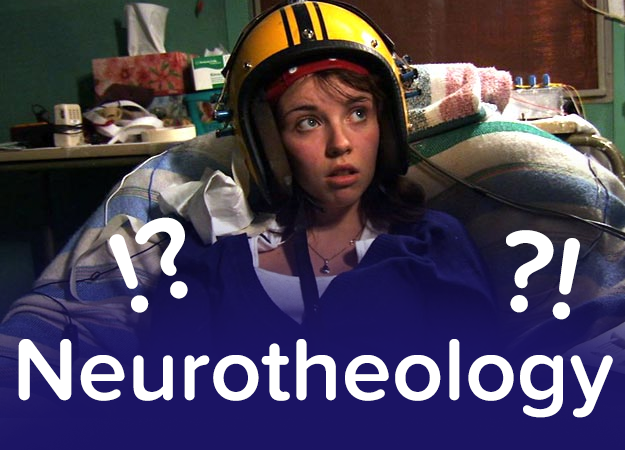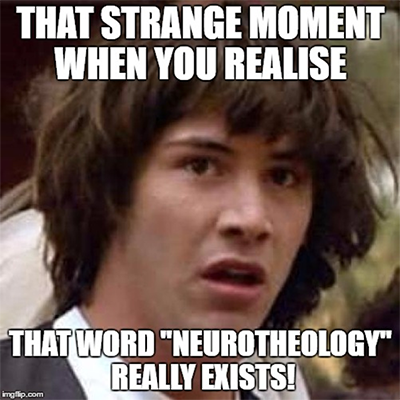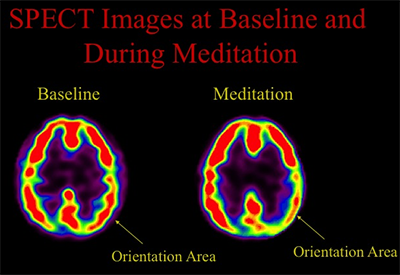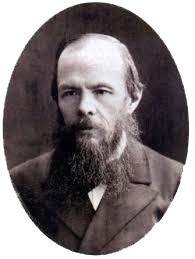Neurology, neuropsychology, neurocognitive science, neurotheology. Wait, WHAT? NeuroTHEOLOGY? What the heck is that?

God Helmet
How do you think, what does the person in the attached picture have on her head? Yes, it's certainly a motorcycle helmet, but what else lies behind it? This thing is called the "God Helmet", and it was used in research conducted by Michael Persinger. When turned on, it stimulates the brain by means of solenoids located around the head next to the frontal, temporal and occipital parts of the brain.
Why is it called "God Helmet"? In Presinger's study, the participants sat on a comfortable armchair, God's Helmet was put on them with special EEG apparatus adapted and then their eyes were covered so that they could see completely nothing. The study's hypothesis was: "All kinds of spiritual experiences can be artificially induced in the laboratory by stimulation of appropriate parts of the brain". The survey involved 600 volunteers. The results turned out to be really astonishing. 80% of the subjects had the impression that someone was in the room (usually behind their back). Religious interpreted this usually as God, the guardian angel, Christ or a deceased family member. A large part of the respondents experienced very strong emotions, some were crying, others claimed to see demons or hear God's voice. The respondents mostly treated their experiences as real, claimed that they really experienced and meet these intangible entities.
The recording of brain activity of the subjects examined with EEG indicated inhibited work of parietal lobe, which is responsible for integrating sensory information among various modalities, including spatial sense and navigation. Probably this caused the feeling of unity or melting with the environment. The EEG also revealed a disrupted performance of the front lobes, which would explain the difficulties of some subjects with a sense of time passing. Hearing voices was correlated with stimulation in speech centers. In addition, when the brain is disturbed by epileptic seizures, stroke or drug use, the left hemisphere of the brain may begin to interpret right hemisphere activity as a distinct existence, or, as the researcher himself calls it, as a "sensed presence" and this could also have been manifested itself in an experiment.

(image source)
Persinger discovered that electric impulses aimed at amygdala induce sexual excitement, whereas concentrated on right hemisphere's temporal lobe creates an impression of unwanted presence, while concentrated on the left hemisphere - a friendly presence. The most famous living atheist, Richard Dawkings connected to God Helmet, felt nothing. Atheists on general were less likely to feel the effects of God's Helmet, perhaps due to the greater level of scepticism. If they experienceed any visions, they were more frequently related to such phenomena as UFOs, flying in the room, or meeting the deceased father.
Neurotheology
The study described above is part of the branch of science known as "neurotheology". The word "neurotheology" appeared first in Aldous Huxley's "Island", where it was used in a more philosophical context. In the current scientific discourse, neurotheology is a scientific discipline of research on spirituality which methodology relies on the use of neurological methods of imaging brain work or influencing brain work such as:
- Electroencephalography (EEG),
- Functional magnetic resonance imaging (fMRI),
- Positron emission tomography (PET),
- Transcranial magnetic stimulation (TMS).

Neurotheology raises a lot of controversy in the scientific world. Opponents have concerns about terminology itself. Theology studies God and his attributes, with which neurotheology has nothing to do with. Some say that within traditional fields of science such as cognitive science and psychology, there is already room for this type of research. There are accusations of reductionism in form of trying to find a single source of such a complicated phenomenon as spiritual experience. The science journalist John Horgan comments on the creation of neurotheology::
” (...) neurotheology, which studies what is arguably the most complex manifestation—spirituality—of the most complex phenomenon—the human brain—known to science. Given that brain researchers have no idea how I conceived and typed this sentence, I doubt they will ever account for religious experiences in all their vast diversity and subtlety”
Neurotheology's enthusiasts point out that it respects both the spiritual and scientific aspects of reality, so it seeks to achieve holism - or at least treat spiritual world in a less reductionist way than hitherto ignoring or patalogizing mystical experiences in other fields of science. Neurotheology treats mystical experiences as real in a phenomenological way - after all, people experiencing spiritual experiences feel them as if they are true, regardless of the ontological nature of these experiences. They have a real impact on human life. And it's is mostly positive as research findings say, so there is a potential in neurotheological research to create induced spiritual states with therapeutic properties.
Andrew Newberg's Research
Another classic research in the field of neurotheology was carried out by the neurobiologist Andrev Newberg. He noticed that the mystical experiences appearing in all religions have many common features. He decided to take a scientific look at this issue. He involved volunteers from 20 different faiths. The study was attended by Franciscans, Tibetan monks and Pentecostal speaking glossolalia. The study conditions were similar to natural conditions and the device measuring their cerebral activity was in another room. Emitting gamma-radiation contrast had been injected into subjects' veins at the moment of religious experience, which allowed to create a spatial image of brain activity. On this basis, the following conclusions were drawn:
- Activity of prefrontal cortex increases significantly during prayer and meditation, which is accompanied by focus and concentration,
- Activity of parietal lobe, which is responsible for spatial orientation, decreases significantly during meditation and deep spiritual experiences, which is responsible for the feeling of overcoming physical limitations of the body and unity with the environment, or "becoming or being part of something larger than us".

(image source)
Knowing that people with damaged superior parietal lobule lose their ability to orientate themselves in space and have problems with defining their body boundaries, Newberg came up with a hypothesis that the reduced activity of this area caused deliberately (e.g. through spiritual exercises) can constantly increase the feeling of unity with the world. The researcher emphasizes that at the present time there is no scientific way to verify whether neurological changes associated with spiritual or mystical experiences indicate that it is the brain that produces these experiences, or whether it "receives" them just like the radio receives electromagnetic waves.
Epilepsy - The Holy Disorder
Now something about a special variety of epilepsy - the epilepsy of temporal lobes. It is based on excessive brain activity (i.e. abrupt electrical discharges) in the temporal lobes. A frequent occurrence of mystical experiences in people with this disease has been observed.

Fyodor Dostoyevski
(image source)
„His mind and heart were flooded by a dazzling light. All his agitation, doubts and worries, seemed composed in a twinkling, culminating in a great calm, full of understanding... but these moments, these glimmerings were still but a premonition of that final second (never more than a second) with which the seizure itself began. That second was, of course, unbearable."
It is believed that people with epilepsy have some common personality traits - and this set of traits is sometimes called an "epileptic personality". David Wulff, a great researcher of psychology of religion, speaks about the symptoms of such a personality:
(…) shows a lack of sense of humour, dependence, excessive attention to detail, feels that events have great personal meaning and occur under the direction of the Divine, compulsive obedience and ritualism, tendency to repeat, deepening of all emotions and inclination to guilt and hypermoralism.
Dewahurst and Beard found that 8 out of 69 patients were interested in religion before the onset of epilepsy and 26 patients after the onset (40%). It is speculated that people with such an affliction and epileptic personality could have had a huge influence on the history of humanity. St. Paul, Muhammad, Joan of Arc are given as examples of such influential figures witch MAY had epilepsy and this kind of personality. Some people associated shaman's "possessing" with epilepsy, although there are tribes that distinguish between these two states (one as a disorder, the other as a mystical experience).
How to Stop Your Brain Waves
Finally, an absolutely phenomenal video. Ken Wilber, a philosopher, psychologist and practitioner of many kinds of oriental meditation shows different types of meditation when connected to the EEG. He is able to manipulate almost freely the brain waves, and temporally nearly completely freezes them. The entire video is accompanied by his commentary explaining what is he doing and what's happening.
Summary
Literature
Dewhurst, K., & Beard, A. W. (1970). Sudden religious conversions in temporal lobe epilepsy. The British Journal of Psychiatry, 117(540), 497-507.
Newberg, A., Alavi, A., Baime, M., Pourdehnad, M., Santanna, J., & d'Aquili, E. (2001). The measurement of regional cerebral blood flow during the complex cognitive task of meditation: a preliminary SPECT study. Psychiatry Research: Neuroimaging, 106(2), 113-122.
Newberg, A., & d'Aquili, E. G. (2008). Why God won't go away: Brain science and the biology of belief. Ballantine Books.
Persinger, M. A., & Tiller, S. G. (2008). Case report: A prototypical spontaneous ‘sensed presence’of a sentient being and concomitant electroencephalographic activity in the clinical laboratory. Neurocase, 14(5), 425-430.
http://www.slate.com/articles/life/brains/2007/04/spirit_tech.html

SteemSTEM is a community driven project which seeks to promote well written/informative Science Technology Engineering and Mathematics postings on Steemit. More information can be found on the @steemstem blog. For discussions about science related topics or about the SteemSTEM project join us on steemSTEM chat.
Being A SteemStem Member
thanks guuys!
This reminds me of reading William James:
I'm not sure, though, that the fact that these experiences can be induced / recorded / analyzed has no bearing on whether these experiences are of some greater value. Although it's certainly not a final word.
Thanks for the quote. I love William James. He wrote a classic psychology piece on religious experiences called The Varieties Of Religious Experience. Haven't read that yet but can't wait to so that.
This is so interesting! Essentially giving more evidence we create our own reality
Yes we do in many ways :)
Please vote back @darmian23
Article really interesting and I see that in your space you have much more, even travel that is another topic that I get very excited with psychology! I'll follow you, I'll try to read your past posts slowly. See you soon!
Thanks! Sorry If my English is sometimes weird :D
No your English is perfect, certainly better than mine !!! ;-)
This is interesting.. and its weird in a way, -theology plus neuroscience.
i did read a bit on the God helmet, but it sounded mostly fictional to me at first
Following this path someday we will even be capable of quantify love and other emotions in an objective way
Really interesting read! Thank you for this enrichment. I will follow you for more!
Thanks for coming by, your criminal.psychology series seems to be interesting too, I'll check them as soon I'll settle down from travel :)
Thanks, I would like to see what you think :)
Hmnnn.... fascinating. I'll have to revisit Ken Wilber. Last time I took a look at what he was doing I didn't connect. But that was at least a decade ago. I have a very active "spiritual" brain. I can shift energies in my brain and feel their migration from one area to another. I do most of my writing, like what I am doing now, on a lower frequency level (that's what I call it) but my best and most inspired writing is done while in a state of higher consciousness or higher frequency. Many of the things that I've come to understand regarding the nature of mind, consciousness, spiritual path can really only be grasped and experienced completely while in a higher state of consciousness. While in that state one can not only comprehend but one experiences things such as the dissolution of boundaries, the melding of all things, or the experience of being the Observer, etc. I find the interface of spirituality and physics to be very fascinating. Spiritual masters from all ages and religions (or not) indeed do have a commonality in mental function. Ah, but it gets tricky, some who consider themselves as enlightened, or at least well on the way, are whack jobs. Me? I've genuinely tried to cross reference what I experience with Jung and Grof and physics. I do enjoy the new theoretical physicist Nassim Harramien from Hawaii. He combines the spiritual realm with his understanding of physics. Blessing upon your head. Appreciate the post.